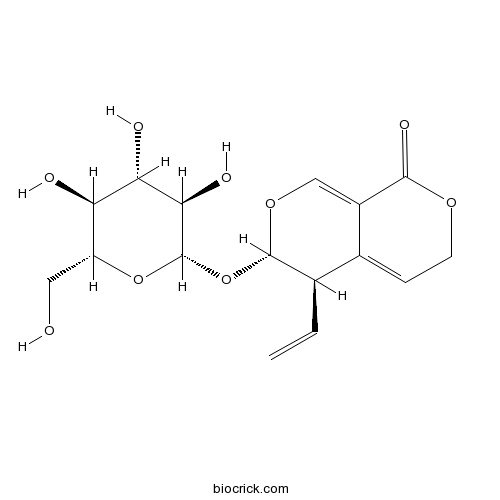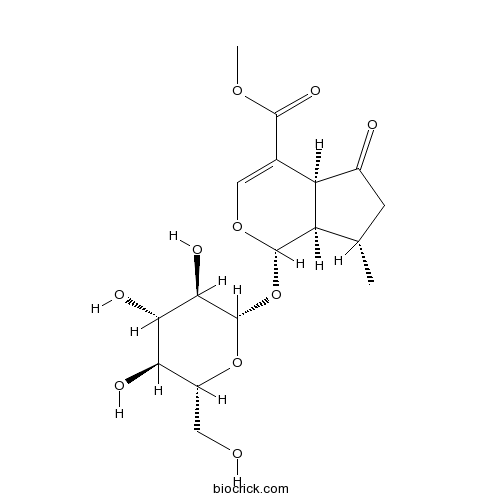Verbena officinalis
Verbena officinalis
1. The products in our compound library are selected from thousands of unique natural products; 2. It has the characteristics of diverse structure, diverse sources and wide coverage of activities; 3. Provide information on the activity of products from major journals, patents and research reports around the world, providing theoretical direction and research basis for further research and screening; 4. Free combination according to the type, source, target and disease of natural product; 5. The compound powder is placed in a covered tube and then discharged into a 10 x 10 cryostat; 6. Transport in ice pack or dry ice pack. Please store it at -20 °C as soon as possible after receiving the product, and use it as soon as possible after opening.
Natural products/compounds from Verbena officinalis
- Cat.No. Product Name CAS Number COA
-
BCN4909
Gentiopicroside20831-76-9
Instructions

-
BCN5355
Aucubin479-98-1
Instructions

-
BCN6898
Hastatoside50816-24-5
Instructions

-
BCN5658
Apigenin520-36-5
Instructions

-
BCN5008
Cornin548-37-8
Instructions

-
BCN4136
Acteoside61276-17-3
Instructions

-
BCN4327
Ursolic acid77-52-1
Instructions

Development and validation of a rapid ultra-high performance liquid chromatography diode array detector method for Verbena officinalis L.[Pubmed: 30096646]
None
Incidence of Pyrrolizidine Alkaloids in Herbal Medicines from German Retail Markets: Risk Assessments and Implications to Consumers.[Pubmed: 28960556]
The occurrence of potentially toxic pyrrolizidine alkaloids (PAs) in herbal medicines (HMs) is currently intensely being discussed in Europe. Pyrrolizidine alkaloids, particularly the 1,2-unsaturated PAs, are undesired compounds in HMs due to their potential hepatotoxic and carcinogenic properties. In this study, 98 widely patronized HMs from six popular German retail supermarkets/drugstores, as well as from pharmacies, were analyzed by high-performance liquid chromatography-electrospray ionization-tandem mass spectrometry for the presence of PAs. The results showed that about 63% of the HMs were PA positive, whereas the average PA concentration of the samples was 201 μg/kg, the highest concentration of PAs (3270 μg/kg) was attributed to a product that was purchased from the pharmacy and contained Hypericum perforatum L. (St. John's Wort) as an active ingredient. In addition, H. perforatum-containing products were frequently contaminated with PAs from Echium spp., while both Cynara cardunculus L. products and fixed-combination products of Gentiana lutea L., Rumex acetosa L., Verbena officinalis L., Sambucus nigra L., and Primula veris L. products were commonly contaminated with PAs of Senecio spp. The study showed that H. perforatum, C. cardunculus, Urtica dioica L., and fixed-combination products were frequently contaminated with PA levels above the recommended values of both the German and European Medicines Agencies.
Anticonvulsant Effects of Aerial Parts of Verbena officinalis Extract in Mice: Involvement of Benzodiazepine and Opioid Receptors.[Pubmed: 28585447]
To evaluate the anticonvulsant activity of the aerial parts of Verbena officinalis used traditionally by local Iranians for the treatment of convulsion. The anticonvulsant activity of the extract was assessed in pentylenetetrazole (PTZ) and maximal electroshock (MES) induced seizures in mice. Diazepam was used as reference drug. In addition, for investigating the mechanism of V officinalis in PTZ model, flumazenil and naloxone were injected before V officinalis. The extract showed no toxicity and significantly increased the period taken before the onset and decreased the duration of the seizures induced by PTZ. In the MES test, V officinalis displayed significant reduction in hind limb tonic extension duration in a dose-dependent manner. The results propose that V officinalis ethanolic extract has anticonvulsant activity against seizure. It seems that these effects may be related to potentiating of GABAergic system. Moreover, this study supports the use of this plant by local Iranians in order to treat convulsion.
Application of benchtop and portable near-infrared spectrometers for predicting the optimum harvest time of Verbena officinalis.[Pubmed: 28411824]
This study examined the applicability of near-infrared (NIR) spectroscopy coupled with multivariate data analysis (MVA) to determine the ideal harvest time of Verbena officinalis. NIR analyses were performed non-invasively on the fresh plant material based on the quantification of the key constituents verbenalin and verbascoside. Vibrational spectroscopic measurements were performed applying a conventional NIR benchtop device as well as a laboratory independent handheld NIR spectrometer. A novel high performance liquid chromatography (HPLC) method was applied as a reference method. For both instruments partial least squares (PLS) regression models were established performing cross validations (CV) and test-set validations (TSV). Quality parameters obtained for the benchtop device revealed that the newly established NIR method enabled reliable quantifications of the main compounds verbenalin and verbascoside related to the dried and fresh plant material. The results of the miniaturised spectrometer revealed that accurate quantitative calibration models could be developed for verbascoside achieving a comparable prediction power to the benchtop device. PLS models for verbenalin were less precise suggesting the application of portable devices including a different spectral range and resolution. The work demonstrated the feasibility of NIR vibrational spectroscopy performing direct measurements on pharmaceutically relevant fresh plant material enabling a quick and simple determination of the ideal harvest time of Verbena officinalis.
Production of verbascoside and phenolic acids in biomass of Verbena officinalis L. (vervain) cultured under different in vitro conditions.[Pubmed: 28278649]
Methanolic extracts from the biomass of Verbena officinalis cultured under continuous artificial light and in darkness on 12 variants of the Murashige and Skoog medium containing different concentrations (0.5-3.0 mg/L) of plant growth regulators: 6-benzyladenine, kinetin, 1-naphthaleneacetic acid and indole-3-butyric acid, were analysed for the amounts of verbascoside and phenolic acids, before and after acid hydrolysis, using the HPLC-DAD method. The amounts of verbascoside were very high (max. 2454.12 mg/100 g DW - light, and 2135.59 mg/100 g DW - darkness). The total amounts of phenolic acids reached a maximum of 46.02 mg/100 g DW (free phenolic acids) and 141.05 mg/100 g DW (bound compounds). The main metabolites were: ferulic, o-coumaric and caffeic acids. The maximum amount of verbascoside was 3.28 times higher than in extracts from the herb of the parent plant. The cultures could be proposed as a potential biotechnological source for selected biologically active compounds.
Synergistic antibacterial effects of herbal extracts and antibiotics on methicillin-resistant Staphylococcus aureus: A computational and experimental study.[Pubmed: 28118725]
Antibiotic resistance has become a serious global concern, and the discovery of antimicrobial herbal constituents may provide valuable solutions to overcome the problem. In this study, the effects of therapies combining antibiotics and four medicinal herbs on methicillin-resistant Staphylococcus aureus (MRSA) were investigated. Specifically, the synergistic effects of Magnolia officinalis, Verbena officinalis, Momordica charantia, and Daphne genkwa in combination with oxacillin or gentamicin against methicillin-resistant (ATCC43300) and methicillin-susceptible (ATCC25923) S. aureus were examined. In vitro susceptibility and synergistic testing were performed to measure the minimum inhibitory concentration and fractional inhibitory concentration (FIC) index of the antibiotics and medicinal herbs against MRSA and methicillin-susceptible S. aureus. To identify the active constituents in producing these synergistic effects, in silico molecular docking was used to investigate the binding affinities of 139 constituents of the four herbs to the two common MRSA inhibitory targets, penicillin binding proteins 2a (PBP2a) and 4 (PBP4). The physicochemical and absorption, distribution, metabolism, and excretion properties and drug safety profiles of these compounds were also analyzed. D. genkwa extract potentiated the antibacterial effects of oxacillin against MRSA, as indicated by an FIC index value of 0.375. M. officinalis and V. officinalis produced partial synergistic effects when combined with oxacillin, whereas M. charantia was found to have no beneficial effects in inhibiting MRSA. Overall, tiliroside, pinoresinol, magnatriol B, and momorcharaside B were predicted to be PBP2a or PBP4 inhibitors with good drug-like properties. This study identifies compounds that deserve further investigation with the aim of developing therapeutic agents to modulate the effect of antibiotics on MRSA. Impact statement Antibiotic resistant is a well-known threat to global health and methicillin-resistant Staphylococcus aureus is one of the most significant ones. These resistant bacteria kill thousands of people every year and therefore a new effective antimicrobial treatment is necessary. This study identified the herbs and their associated bioactive ingredients that can potential the effects of current antibiotics. These herbs have long history of human usage in China and have well-defined monograph in the Chinese Pharmacopeia. These indicate their relatively high clinical safety and may have a quicker drug development process than that of a new novel antibiotic. Based on the results of this study, the authors will perform further in vitro and animal studies, aiming to accumulate significant data for the application of clinical trial.


